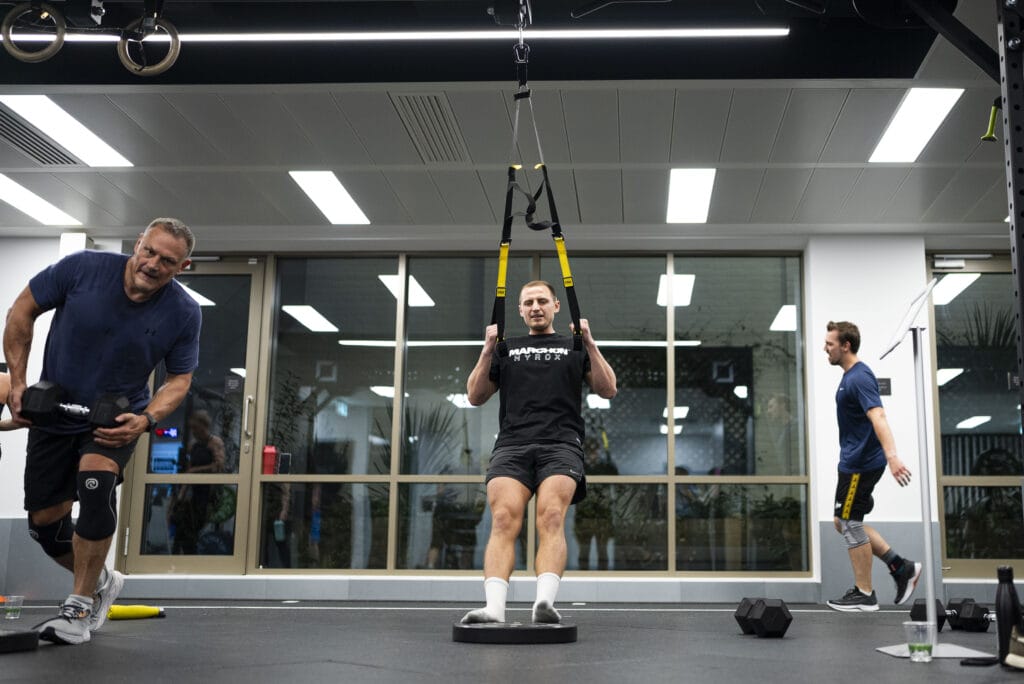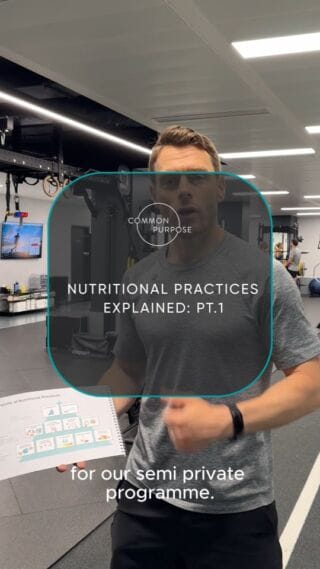Whether you’re striving for a specific athletic goal, like fat loss, or aiming to become a versatile all-rounder, capable of engaging in a diverse array of physical activities, our mission at Common Purpose is to unlock your full potential and help you achieve your performance goals through our One to One PT and Semi Private PT offerings.
We design our training programmes using evidence-based methods, ensuring they meet our members’ needs and goals. With our experienced and motivating personal trainers, our members benefit from the latest training techniques to become the fittest, strongest, and most athletic version of themselves.
Embarking on a fat loss journey requires more than just willpower; it demands a strategic approach that balances realistic goals, tailored nutrition, effective training, and ongoing support. In this article, we’ll walk you through our comprehensive approach to fat loss, designed to help you achieve sustainable results while maintaining your overall well-being.
1. Education: The Science Behind Fat Gain and Loss
Before diving into the specifics of setting goals and creating a plan, it’s essential to understand the science behind fat storage and fat loss. By grasping the mechanisms of how our bodies store fat and how they lose it, we can better appreciate why fat loss ultimately boils down to managing our energy balance.
Mechanisms of Fat Storage and Fat Loss
Fat storage is a process deeply rooted in the body’s need to maintain energy balance. When you consume more calories than your body immediately needs, a majority of the excess energy is stored in adipose tissue, commonly known as body fat. This storage occurs as triglycerides, which are molecules formed by the combination of glycerol and fatty acids.
When your calorie intake exceeds your energy expenditure (the calories burned through basal metabolic rate, physical activity, and digestion), the surplus is stored as fat. This process is protective from an evolutionary standpoint, as it ensures that the body has energy reserves during times of scarcity.
On the flip side, fat loss occurs when you create a calorie deficit—consuming fewer calories than your body needs. In response, the body begins to break down stored fat into fatty acids and glycerol, which are then used as energy. The breakdown of fat not only provides energy but also results in a reduction in body fat.

Fat Storage – An Evolutionary Necessity
From an evolutionary standpoint, the ability to store fat was a critical survival mechanism. Early humans lived in environments where food availability was unpredictable, and periods of abundance were often followed by scarcity. Fat storage allowed them to survive during these lean times by providing a reliable energy reserve.
This evolutionary trait, while beneficial for survival in the past, can be a double-edged sword in today’s environment, where food is abundant and often high in calories. Our bodies are still wired to store fat as a protective measure, even though the modern environment no longer requires such extensive energy reserves. This is why managing calorie intake is so crucial in the context of fat loss—our bodies are naturally predisposed to hold onto fat as a safeguard against future food shortages.
2. Setting Goals and Expectations
The foundation of any successful fat loss journey begins with setting clear, realistic goals. Understanding the rate at which you can lose fat is crucial to managing expectations and avoiding frustration. Here’s how we categorise fat loss rates:
- Extreme: 1-1.5% of body weight per week
- Reasonable: 0.5-1% of body weight per week
- Comfortable: Less than 0.5% of body weight per week
Your starting position plays a significant role in determining the rate of fat loss. If you have more weight to lose, you might experience faster initial results. However, as you get leaner, the process naturally slows down, requiring more effort and discipline to continue making progress.
We also emphasise the importance of understanding the cost of getting lean. The leaner you become, the more sacrifices you’ll need to make in terms of diet, social life, and lifestyle choices. It’s essential to be aware of these trade-offs so you can make informed decisions about how lean you want to get and maintain.
To keep the journey engaging and manageable, we recommend setting goals every quarter (approximately 12 weeks). This timeframe is ideal for seeing tangible results while keeping motivation high. Goals can be either outcome-oriented, such as losing a specific amount of body fat or weight, or process-oriented, like setting consistency or habit building goals, for example; training a certain number of times a week, averaging 10,000 steps daily, and eating three portions of protein each day. Often, we combine both types of goals, as process goals are the building blocks that lead to desired outcomes.

Coaching Tools and Methods:
- SMART Goal Setting: We guide you through the process of setting Specific, Measurable, Achievable, Relevant, and Time-bound goals to ensure clarity and focus.
- Quarterly Planning Sessions: Every 12 weeks, we conduct planning sessions to set and review both outcome-oriented and process-oriented goals, keeping your journey engaging and manageable.
- Lifestyle Impact Analysis: We help you assess the trade-offs involved in pursuing lower body fat levels, ensuring you make informed decisions about how lean you want to get.
3. Measuring and Tracking Progress
Measuring and tracking your progress is vital for understanding whether your approach is working and for making necessary adjustments. We use a variety of tools to monitor progress, tailored to each individual’s needs and preferences:
- Daily Morning Weigh-ins: We encourage daily weigh-ins using digital scales to track weight trends, providing context for daily fluctuations by focusing on weekly averages.
- Body Composition Scans: Our InBody scanner is used weekly or bi-weekly to provide detailed insights into changes in muscle mass, fat mass, and overall body composition.
- Circumference Measurements: Regular tape measurements of key areas like the waist, hips, and arms help track physical changes that might not show up on the scale.
- Progress Photos: We recommend taking photos at regular intervals to visually document your transformation, offering a powerful reminder of your progress.
4. Nutrition: Building a Strong Foundation
We view nutrition as the cornerstone of fat loss, and our approach is both flexible and layered, designed to meet you where you are in terms of knowledge, readiness, and ability to change. We conceptualise our nutrition strategy as a pyramid, with each level building on the foundation below it.
1 Basic Nutrition Foundations:
- Focus on Whole Foods: Prioritise nutrient-dense, minimally processed foods as a means of controlling hunger, calorie balance and ensuring good health and wellbeing. We provide education and awareness around whole foods and making better food choices. We also create customised meal plans and food preparation guidance that helps prioritise whole foods.
- Hydration: Hydration is crucial for consistent energy levels, controlling hunger regulation and supporting training performance. Smart water bottles and checking urine colour can help you monitor your daily water intake to ensure you stay hydrated.
- Limit Alcohol: We have open and honest conversations about alcohol consumption with our members, we also educate about excessive and acceptable intake. From here we set targets to help reduce consumption to avoid empty calories and potential metabolic disruptions.
- Protein Focus: Emphasise sufficient protein intake to support muscle retention and satiety. We provide protein targets, and education regarding high-protein foods to help you easily reach your daily protein goals.

2 Eating for Specific Goals:
- Portion Control: Understand and manage portion sizes to avoid overeating. We teach portion control using visual cues and practical tools like portion control plates and hand-size guidelines.
- Calorie and Macro Counting: Track caloric intake and macronutrient distribution (carbohydrates, proteins, fats) to align with your fat loss goals. Tools like MyFitnessPal help us set your calorie and macronutrient targets based on evidence based recommendations, and allow you to track your intake over time.
- Nutrient Timing: Limiting the time you’re able to eat can help reduce your calorie intake without having to count. It also helps some people with digestive and gut health issues. We provide guidance on optimising meal timing around your training schedule to enhance performance and recovery. There are also intermittent fasting apps that can help you stick to your fasting routine.
- Food Journaling: Creating awareness of your eating habits can help identify patterns and behaviours that may not align with your goals and reveal the emotions and feelings associated with food. We encourage food journaling, whether digitally or on paper, to help uncover these patterns and highlight areas for improvement.
3 Nutrition Optimisation:
- Blood Testing: Analyse key biomarkers can help tailor nutrition and supplementation for optimal health and performance. We can recommend specialist companies that conduct blood tests that inform personalised nutrition and supplementation strategies.
- Supplementation: Using supplements can help fill nutritional gaps and support your goals. Based on your specific needs, we advise on the strategic use of supplements to fill nutritional gaps and support your fat loss goals.
We believe everyone should focus on Level 1 nutrition for overall health and well-being. If your goal is fat loss, Level 1 nutrition might be sufficient. However, if it’s not enough to achieve your goals, we will introduce more advanced strategies to ensure your success.
5. Training: A Balanced Approach
Although we prioritise nutrition when it comes to fat loss, we also believe that training is an important component of the fat loss journey, and we advocate for a balanced approach that combines cardiovascular training, resistance training, and increased daily activity. Here’s why this blend is optimal:
- Cardiovascular Training: Boosts calorie expenditure, improves cardiovascular health, and enhances fat utilisation. We provide tailored targets and programs for cardiovascular training both inside and outside of the gym. Using heart rate monitors and fitness apps can help you track and optimise your cardio sessions to maximise calorie burn and fat utilisation.
- Resistance Training: Helps maintain and build muscle mass, which is crucial for preserving metabolic rate during fat loss. We design and implement progressive resistance training programs that focus on building and maintaining muscle mass and strength, ensuring your metabolism remains efficient throughout your fat loss journey.
Increased Daily Activity: Tracking steps is a simple way to increase overall energy expenditure and combat sedentary habits. We recommend using fitness trackers to monitor your daily steps, encouraging you to reach a goal of 10,000 steps per day to boost overall energy expenditure.

6. Ongoing Coaching and Check-ins
Fat loss is not a linear journey; it’s filled with ups, downs, and plateaus. We understand that life—whether it’s family obligations, social engagements, or stress—often interferes with progress. That’s why ongoing coaching and regular check-ins are integral to our approach.
Coaching Tools and Methods:
- Weekly Check-ins: Regular check-ins via in-person meetings, video calls, or app-based messaging ensure you receive timely feedback and support.
- Plateau-Beating Strategy Sessions: We provide tailored strategies to overcome plateaus, such as adjusting calorie and macro intake, updating your workout routine, or implementing strategic diet breaks.
- Mindset Coaching: Our mindset coaching focuses on helping you navigate challenges, maintain motivation, and develop a resilient approach to setbacks.
Rather than taking a dictatorial stance, we act as guides, providing support, accountability, and adjustments as needed. Whether you’re hitting a plateau, struggling with motivation, or simply need encouragement, we’re here to help you navigate the challenges and stay on course.
Conclusion
Achieving and maintaining fat loss requires a well-rounded approach that balances goal setting, progress tracking, tailored nutrition, effective training, and continuous support. By setting realistic expectations, building a solid nutritional foundation, engaging in a balanced training regimen, and having ongoing coaching, you can not only achieve your fat loss goals but also maintain them in the long term. Remember, this journey is about progress, not perfection—celebrate every victory, no matter how small, and keep moving forward.
Want to start your muscle building journey with one of our expert trainers today? Get in touch.




